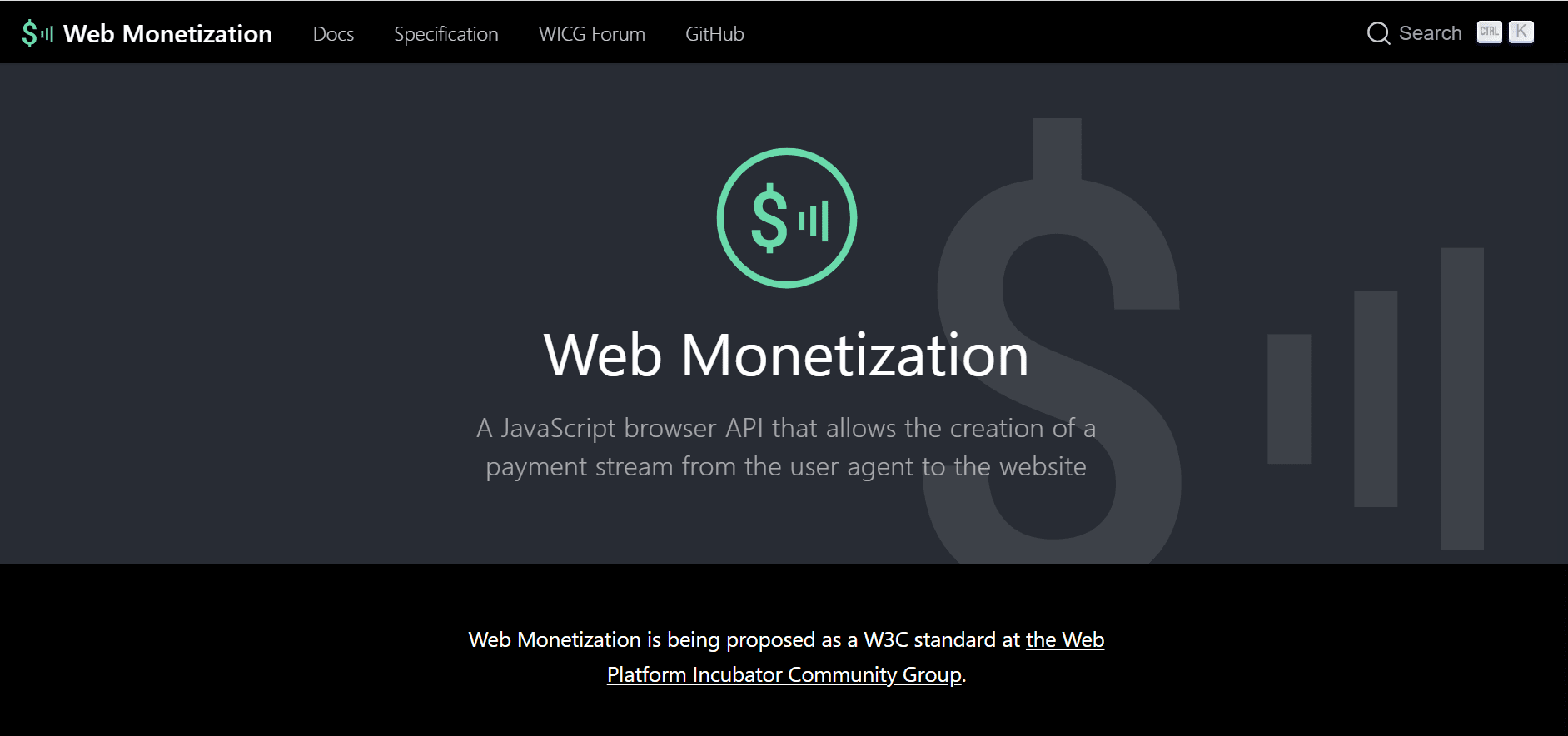As the internet has evolved, so have the ways in which content creators and website owners have monetized their content.
Traditional online advertising and subscription models have been the primary methods for generating revenue, but they come with their own set of challenges, such as ad-blocking and subscription fatigue. That’s where Web Monetization comes in.
What is Web Monetization?

Web Monetization is a new way of monetizing web content that allows website owners and bloggers to receive micro-payments from users in exchange for access to their content or services.
It is a new standard developed by the World Wide Web Consortium (W3C) that aims to make it easier for web developers and publishers to receive payments from users without relying on traditional online advertising or subscription models.
With this monetization model, users can make small payments to content creators or service providers using a variety of payment methods, including cryptocurrency, credit cards, and digital wallets. These payments are processed through a secure system that uses a digital payment protocol called Interledger, which allows for seamless and near-instantaneous transactions across different payment networks.
Web Monetization can be used by a wide range of websites and online services, including news sites, blogs, video platforms, social media networks, and more. It offers a new revenue stream for content creators and website owners, while also providing users with a way to support their favorite creators and access high-quality content without having to endure ads or pay for subscriptions.
How Web Monetization works
To use web monetization, a content creator adds a unique payment pointer to their website’s HTML. This payment pointer is linked to the creator’s digital wallet. When a user visits the monetized website, their web monetization provider (typically a browser extension or built-in functionality in some browsers) detects the payment pointer and starts streaming micropayments to the creator’s wallet.
Users who want to support web-monetized content can sign up with a web monetization provider and add funds to their accounts. The provider then automatically handles the distribution of micropayments to creators as the user consumes content.
Key components
Web monetization relies on two main components:
- Interledger Protocol (ILP): An open protocol that enables the transfer of small amounts of money across different payment networks in real time.
- Web Monetization API: A set of standards that facilitate the integration of web monetization into websites.
What is a Web Monetization provider?
A web monetization provider is a service or platform that facilitates the process of streaming micropayments from users to content creators as part of the web monetization ecosystem. These providers enable users to support their favorite creators directly by sending small amounts of money in real time while consuming web-monetized content.
Web monetization providers typically offer the following services:
- User account management: Users sign up with the provider, create an account, and add funds that will be used to support web-monetized content.
- Payment processing: The provider handles the streaming of micropayments from the user’s account to the content creator’s digital wallet. This process uses the Interledger Protocol (ILP) and Web Monetization API to enable seamless and secure cross-platform transfers.
- Compatibility with digital wallets: The provider ensures compatibility with various digital wallets that support the Interledger Protocol, making it easy for content creators to receive micropayments.
To use web monetization, users need to choose a web monetization provider and sign up for their services. Some web monetization providers may charge a small fee for their services, while others might offer free services with certain limitations.
Although Coil was a well-known web monetization provider in the past, it is no longer active. There aren’t many providers that work as well as Coil, though users can still use digital wallets like Uphold and Gatehub directly.
Understanding web monetization and its benefits
Seamless micropayments
Web monetization relies on open protocols like the Interledger Protocol (ILP) and Web Monetization API to enable seamless micropayments.
ILP allows small amounts of money to be transferred across different payment networks in real-time, while the Web Monetization API helps browsers detect and stream micropayments to creators.
The mechanics of web monetization
Here’s how web monetization works for you as a creator:
- Payment pointers and digital wallets: You’ll need a unique payment pointer linked to your digital wallet. This pointer is added to your website’s HTML and enables your audience to stream micropayments to your wallet.
- Web monetization providers and user accounts: Your audience will sign up with a web monetization provider, such as Uphold, and add funds to their account. The provider handles the distribution of micropayments to you as users consume your content.
Setting up web monetization for your content
Choosing a digital wallet
To get started, you’ll need a digital wallet compatible with the Interledger Protocol. Some popular options include Uphold and GateHub.
Generating a payment pointer
Once you have a digital wallet, create a payment pointer associated with your wallet. This pointer is unique to you and allows users to send micropayments directly.
Adding the payment pointer to your website
Insert the payment pointer into your website’s HTML code by adding the following meta tag:
bashCopy code<meta name="monetization" content="$your.payment.pointer">
Replace $your.payment.pointer with your actual payment pointer.
Promoting your web-monetized content
Inform your audience about your web-monetized content by:
- Adding a web monetization badge or banner to your website.
- Sharing the news through social media and email newsletters.
- Encouraging your audience to sign up with a web monetization provider.
Becoming a web monetization user
As a content creator, you might also want to support other creators through web monetization. Here’s how:
- Selecting a web monetization provider: Sign up with a web monetization provider, such as Uphold, to support creators by streaming micropayments.
- Adding funds to your account: Load your account with funds that will be used to support creators as you consume their content.
- Discovering and supporting web-monetized content: Explore and engage with web-monetized content created by other creators. As you consume their content, your web monetization provider will automatically distribute micropayments to the creators.
Benefits of Web Monetization
For content creators
- Direct revenue streams: Web monetization enables creators to receive payments directly from users without intermediaries.
- Reduced reliance on advertising: Creators can focus on creating high-quality content without relying on ads that may disrupt the user experience.
- Greater creative freedom: With a more direct and stable revenue stream, creators can explore a wider range of content and topics.
For readers (content consumers)
- Ad-free browsing experience: Users can enjoy a cleaner browsing experience without intrusive ads.
- Supporting creators directly: Users can directly support their favorite creators, fostering a stronger creator-consumer relationship.
- Access to content without subscriptions or paywalls: Web monetization makes content more accessible by eliminating the need for subscriptions and paywalls.
For the internet ecosystem
- More equitable distribution of revenue: Web monetization encourages a more balanced distribution of income among creators, fostering a diverse range of content.
- Encouraging innovation and diverse content: By reducing barriers to entry and supporting creators directly, web monetization can lead to more innovative and diverse content.
Conclusion
Overall, Web monetization offers a promising alternative for content creators seeking to monetize their work while enhancing the user experience. By providing a more sustainable revenue model for content creators and a better user experience for users, Web Monetization could create a more vibrant and equitable web ecosystem.
While there are still challenges to be addressed, the potential benefits of Web Monetization make it an exciting development to watch in the years to come.


